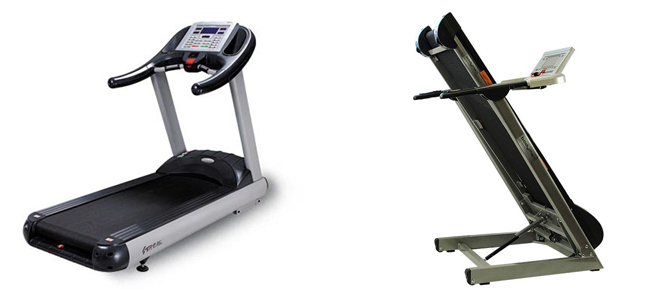Folding or Non Folding Treadmills

Treadmills are one of the most popular pieces of home gym equipment. If you’ve decided to invest in one you’re likely to be faced with a dilemma; folding or non-folding? This folding and non-folding treadmill comparison will give you an outline of the advantages and disadvantages of each type of treadmill and which is likely to be suited to your needs.
Firstly, before diving into the folding and non-folding treadmill comparison, it’s important to understand the differences between the two models. A non-folding treadmill is your standard treadmill that you’ll find in health clubs and gyms up and down the country. A folding treadmill however, as the name suggests, is designed to be folded and put away.
The main difference that any folding and non-folding treadmill comparison site will tell you is sturdiness. As the larger, more bulky machine, the non-folding treadmill will operate up to high speeds under the heaviest users without wobbling. Non-folding treadmills are less sturdy, although this does not mean that they are not sturdy at all. Top of the range folding treadmills are also built to a high standard and can often be adequate in terms of stability for the user.
Other Considerations With a Non-Folding Treadmill
In addition, the non-folding models are stronger and built using the finest components; particularly higher range models. It is important to remember in folding and non-folding treadmill comparison that the non-folding models, by nature, are usually the better quality, more powerful machines.
Why Choose A Folding Model?
The trade off in quality is for space. A folding treadmill can be packed up and stored in a cupboard or underneath your bed, whilst a non-folding model is bulky and is likely to take up a considerable space. Sure, if you have a home gym and plenty of room this is not an issue but, for the majority of users, filling a living room with a whacking great treadmill is not really an option.
Another point to consider is the ease of cleaning around a folding model. With inbuilt wheels and lightweight structure, they can easily be moved if you need to vacuum underneath. With the non-folding models, this is more difficult as a result of their size and weight.
Price Considerations
The non folding units tend to be more expensive, although this is largely due to their strength, stability and general quality of the treadmill.
The key to buying a treadmill is trying before you buy. If you’re concerned about space, check out the folding models. Just because they’re not as stable as the non-folding units doesn’t mean they aren’t suitable for your needs. Make sure you have a go on a model and, if it feels stable and you are comfortable with the machine, a folding option may well be adequate.
In Summary
In conclusion, for many home fitness purposes, a folding treadmill is a fantastic purchase. Whilst there is reduced stability, it is still possible to get fit and lose weight without investing large sums of money in a non-folding machine. Despite this, if you are serious about running and have the space to fit a non-folding model in, it may well be worth investing for the more stable unit.





